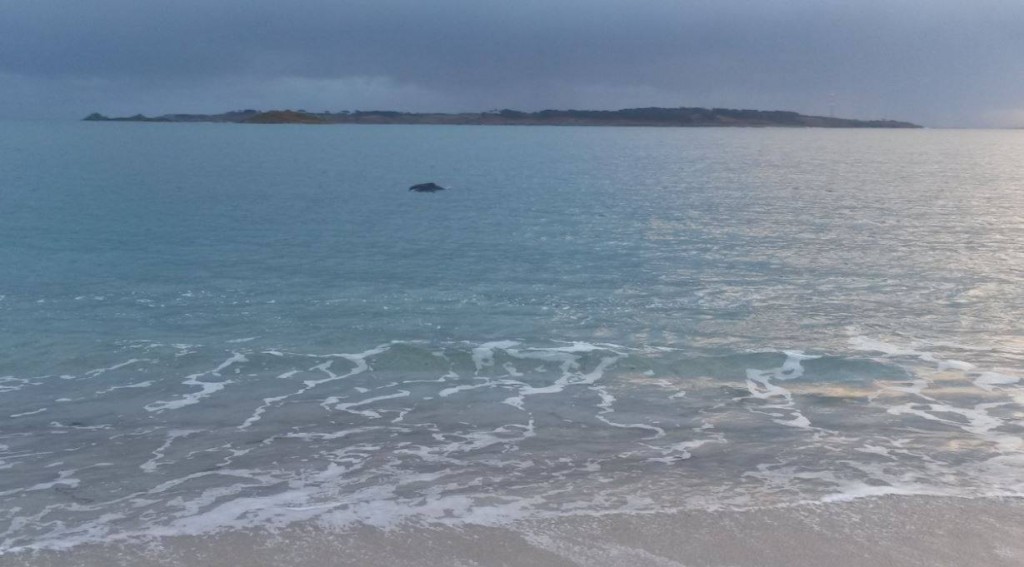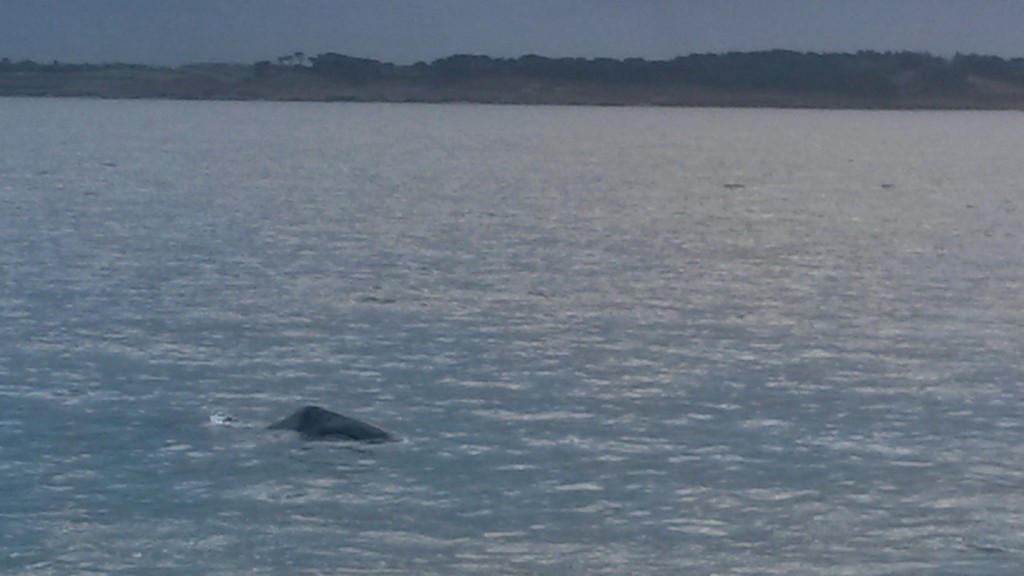Mystery whale in Cornish waters challenges experts but leads to exciting conclusion – a first for Britain and Europe
Sea Watch Foundation regularly receives unusual reports and photographs of mystery animals from the seas around the UK, and this week has proved no different, with an extra special sighting close off the Isles of Scilly in Cornwall.
The sighting was made last Friday (20th February) and logged on the Sea Watch website over the course of the weekend as a sperm whale, which would have been interesting in itself in such shallow waters. Eager to positively identify the mystery whale, Sea Watch’s Sightings Officer, Kathy James, entered into dialogue with the observer to find out more. Anna Cawthray forwarded a series of photographs to the research organisation, which had been taken on her friend’s mobile phone depicting a c. 25 ft whale that she’d encountered just metres off Par Beach on the beautiful and remote island of St Martin’s (49o57’ N) in the Isles of Scilly (photo 1). Needless to say, taking photos on a mobile phone makes it challenging for identification. The observer reported that when it surfaced and dived again, it showed no dorsal fin. This is probably what influenced local naturalists to think this was a sperm whale, the only other large whales without dorsal fins being the near extinct North Atlantic right whale, the bowhead whale of the high Arctic and the gray whale from the North Pacific. Believing that the photographs showed something quite special, Kathy forwarded the images to Sea Watch Foundation’s Founder and Director, Dr Peter Evans, whose field experience of cetaceans goes back 45 years.
Photo 1: The mystery whale photographed by Fay Page / Sea Watch Foundation
“The images were indeed a challenge”, admitted Dr Evans. “Even with enlarging them, and trying to sharpen them up within Adobe Photoshop, it was very hard to pick out the more subtle features due to the low resolution of the pictures, or even to tell exactly what part of the body was showing in some of the photos. One image, however, showed the animal closer than the rest, and revealed the shape of the head and even the jaw-line” (see Photo 2).
Photo 2: The head of the whale, photographed by Fay Page / Sea Watch Foundation
Looking at it close up, Dr Evans said that one could just make out that the jaw-line curved downwards somewhat at the base. The shape of the head and jaw-line ruled out sperm whale and confirmed that it was a baleen whale but still one couldn’t be certain of the species. The pyramidal shape of the head with what looked like a line of callosities along the top led Dr Evans to think it might be a young gray whale. Gray whales went extinct in the North Atlantic in the eighteenth century but in May 2010, amazingly, one was photographed off Israel and then three weeks later the same individual was seen and photographed off Barcelona in Spain. Three years after that, in May 2013, a second individual was photographed for the first time south of the equator off Namibia, Southwest Africa. These two individuals were both assumed to have entered the Atlantic from the North Pacific via the Northwest Passage now that it has become ice-free at times.
Dr Evans was less familiar with bowhead whale, and seeking further opinion, sent the images to colleagues in the United States – Dr Tom Jefferson from Texas A&M University, Dr Phil Clapham from the government agency NOAA in Washington DC, and Dr Scott Kraus from New England Whale Museum in Provincetown. They in turn consulted with other colleagues from all around North America, including specialists on particular species – gray whale, North Atlantic right whale, and finally, bowhead whale. The more specialists that were involved, the firmer the view became, that the animal was indeed a young bowhead whale. It was decided that the apparent callosities on the top of the head were a trick of the light, and one could just make out some black spotting along the top, a key feature of bowheads. The head shape and jaw-line also fitted the species, as did the light patch under the chin, and of course, the lack of a dorsal fin. Although it is very difficult to estimate size, Anna’s observations and the photograph of herself near the animal (see Photo 3) suggest that it was a juvenile since the species can grow to a length of up to c. 65ft.
This extraordinary sighting, the first of this species in the UK, has not been recorded elsewhere in Europe (south of the Barents Sea). Bowheads normally live in the high arctic. Heavily exploited by whalers in the Arctic Ocean, in Baffin Bay off Greenland, and the Barents Sea north of Norway, the population seriously declined during the early twentieth century from numbers historically estimated to be around 30,000-50,000, reaching a low in the 1920s of c. 3,000. With the cessation of commercial whaling in the latter half of the last century, numbers globally have increased to somewhere between 15,000 and 20,000, mainly in the Beaufort Sea and Arctic Ocean. The Eastern Arctic-West Greenland population has increased recently and now is thought to number well over 3,500. There are no good estimates of abundance for the Spitsbergen and Okhotsk Sea stocks but they have shown no signs of significant recovery, and probably still number only a few hundred.
Photo 3: Anna wades into the water to get a closer view of the animal, which shows little reaction to her presence. Photo: Fay Page / Sea Watch Foundation
Dr Evans commented: “bowhead whales are unusual amongst whale species in being largely confined to the coldest parts of the world, generally never far from the ice edge. So to appear this far south may seem enigmatic, particularly when seas are warming, thus encouraging species to extend their ranges further north. In March 2012, a bowhead whale was photographed in Cape Cod Bay, New England (42o N), and the same individual re-appeared in the same area a year later, in early April. These records far from the natural range of the species may in fact be the result of ice fragmentation, leading to animals straying further south. The welcome increase in the size of the West Greenland population may also be a contributory factor for why this creature appeared some two thousand miles from its normal range.”
Bowhead whale facts
Size: Length up to 18 metres (males) and 20 metres (females) and can weigh as much as 90 tonnes!
Head: Large (c. 40% of the body length) with a strongly arched mouth-line, and the eye placed just above the corner of the mouth. The baleen plates are the longest of any whale species – up to 14 ft long. The large head may be used to break through pack ice.
Body: Very rotund with a prominent bulge in the blowhole at the back of the head and a distinct depression behind that. There is no dorsal fin, but a slight dorsal hump in the middle of a smooth back. Coloration is generally dark, except for the tip of the lower jaw, which is pale (sometimes a pale area also around the tail, and occasionally on other parts of the body). Its blubber is the thickest of any whale.
Life Span: 100-200 years making this possibly the longest-lived of all marine mammals (evidence coming from old harpoon heads found in hunted individuals, and aspartic acid analysis from eye tissue). Bowheads reach sexual maturity at around 20 years of age.
Feeding: Small crustaceans (mainly copepods & krill) taken from near the surface by skim feeding.
Threats: Commercial whaling for bowhead whales started in the 1500s. However, as with several baleen whale species, most damage is thought to have occurred during the late nineteenth and early twentieth century, resulting in four of the five recognised stocks becoming highly endangered. The Bering-Chukchi-Beaufort (Western Arctic) stock is the only one with sizeable numbers (c. 10,000-13,000), increasing at c. 3% per annum, but, more recently, some of the other stocks have started to recover. Other threats include noise disturbance from oil & gas exploration activities, entanglement in fishing gear, and pollution.



























